
South China Sea: Philippines’ David vs Goliath sovereignty struggle encapsulated – in tiny Thitu Island
- Underdeveloped Thitu Island, or Pag-asa (hope), lies just 27km northeast of a military base built by China that’s estimated to be 12 times its size
- Still, Manila is determined to maintain a civilian and military presence, and is planning to pour billions of pesos into upgrading the remote outpost
Manila is rushing to develop the 33-hectare (82-acre) Thitu Island, with the government planning to pour in billions of pesos to upgrade it. Just over 200 civilians and military personnel currently live there.

That base is just one of Beijing’s 27 outposts in the South China Sea equipped with ports, runways and other infrastructure aimed at asserting its sweeping claims in the key waterway.
Fortified South China Sea islands help project Beijing’s power: experts

On a recent visit to Thitu – which is also known as “Pag-asa”, the local word for hope – arranged by the Philippine Coast Guard, reporters saw first hand just how underdeveloped the Philippines’ largest-occupied feature in the disputed sea is.
Much of the island is still unpaved, with phone and internet signals hard to come by. There’s still evidence of the destruction caused by a 2021 typhoon: school buildings with damaged roofs and windows that are unusable.
Given its location – nearly 450km away from mainland Palawan province – residents sometimes wait days for basic supplies like noodles, coffee and soap to be ferried in. The coastguard’s new monitoring station appears largely rudimentary.
Still, the Southeast Asian nation is determined to maintain a civilian and military presence on Thitu. Aircraft can now land on its runway after repairs and expansion. A landing dock and a port have also been built, and construction is in full swing to extend the island farther into the sea. There are plans to equip the area with a naval port and radars.

“Our overarching strategy involves continuous enhancement of facilities, modernisation efforts, and fortification of assets and capabilities,” Philippine military spokeswoman Colonel Francel Margareth Padilla said when asked about plans for Thitu. “These measures are vital in upholding our sovereignty over Philippine territorial waters.”
China warns close military ties between US, Philippines could trigger conflict
“At first, this was intended to coerce the Philippines into abandoning the upgrades,” said Gregory Poling, who directs the Southeast Asia programme at the Centre for Strategic and International Studies in Washington.
“Now, it seems meant to merely intimidate the Philippines but with little chance of success.”

